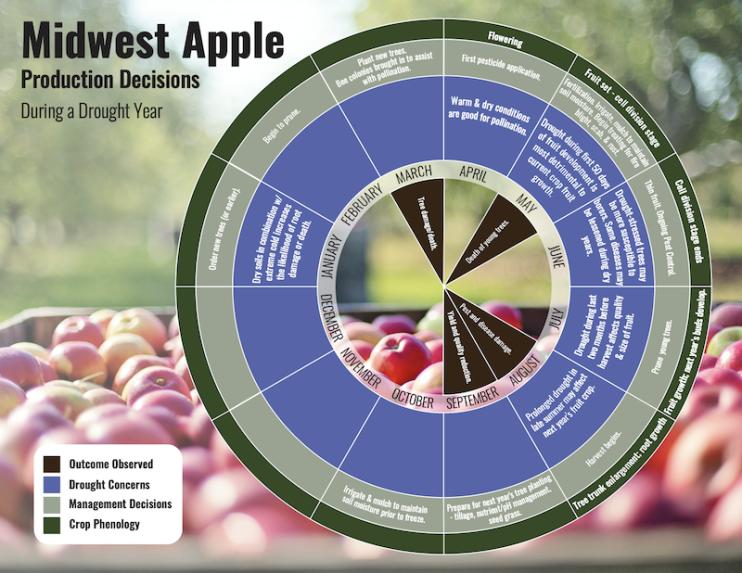Midwest Crop Production Decision Calendars and Fact Sheets
The project, Connecting Drought Early Warning to the Decision Making Needs of Specialty Crop Producers in the Midwestern United States, developed a set of decision calendars that provide month-by-month and seasonal advice on how growers manage production of Midwestern apple, grape, cranberry, and irrigated potato crops during drought years. Fact sheets highlighting appropriate drought and climate tools for monitoring conditions during the growing seasons and beyond are also available. The project was funded by NIDIS and led by the National Drought Mitigation Center and the University of Wisconsin, with the U.S. Department of Agriculture Midwest Climate Hub. Advisors included representatives from Iowa State University, the Iowa Winegrowers Association, University of Missouri Extension, University of Wisconsin-Madison Extension, Wisconsin Potato and Vegetable Growers Association, and Wisconsin State Cranberry Growers Association.
The decision calendars feature up to four categories—crop phenology, management decisions, drought concerns, and outcome observed—of information per month. You can also view text-based table versions of these decision calendars below. The associated fact sheets on drought and climate tools for perennial fruit, cranberry, and annual vegetable production provides growers with information on using tools such as the U.S. Drought Monitor (USDM), Evaporative Stress Index (ESI), and maps of soil moisture, soil temperature, and snowfall at appropriate times throughout the year to inform decision-making. The fact sheet also highlights new tools that can help growers of perennial crops imagine future growing conditions in their region and plan strategically using that information.
Midwest Crop Decision Calendar Tables
| Month | Crop Phenology | Drought Concerns | Outcome/Impact Observed | Management Decisions |
|---|---|---|---|---|
| December | ||||
| January | Dry soils in combination with extreme cold increases the likelihood of root damage or death. |
Order new trees (or earlier). | ||
| February | Begin to prune | |||
| March | Tree damage/death. | Plant new trees. Bee colonies brought in to assist with pollination. | ||
| April | Flowering | Warm and dry conditions are good for pollination. | First pesticide application. | |
| May | Fruit set- cell division stage | Drought during first 50 days of fruit development is most detrimental to current crop fruit growth. | Death of young trees. | Fertilization. Irrigate, mulch to maintain soil moisture. Begin treating for fire blight, scab, and rust. |
| June | Cell division stage ends | Drought-stressed trees may be more susceptible to borers. Some diseases may be lessened during dry years. | Thin fruit. Ongoing pest control. | |
| July | Fruit growth: next year’s buds develop | Drought during last two months before harvest affects quality and size of fruit. | Prune young trees. | |
| August | Tree trunk enlargement: root growth | Prolonged drought in late summer may affect next year’s fruit crop. | Pest and disease damage. | Harvest begins. |
| September | Yield and quality reduction. | Prepare for next year’s tree planting – tillage, nutrient/pH management, seed grass. | ||
| October | Irrigate and mulch to maintain soil moisture prior to freeze. | |||
| November |
| Month | Crop Phenology | Drought Concerns | Outcome/Impact Observed | Management Decisions |
|---|---|---|---|---|
| December | Winter injury. | |||
| January | Dry conditions during winter increases likelihood of winter injury. |
Root death. |
||
| February | Drought can weaken trunks and canes, and increase susceptibility to disease. | Soil health. | Prune | |
| March | Bud break | Young plants are most sensitive to dry weather. | Trunk damage. | Plant new grapevines. |
| April | Dry weather decreases severity of fungal disease. | Death of young plants. | Begin to spray fungicides and control weeds. | |
| May | Flower formation and fruit set | During drought, plants may support fewer fruit clusters. | Thin grape clusters. | |
| June | Drought lessens disease and weed pressure, though insect pressure may be greater. Dry conditions help to restrict vegetative growth of plants. | Spider mites. Weeds. | Begin to spray insecticides. Thin leaves. Continue to spray fungicides. | |
| July | Berry ripening | Irrigation, plus proper pruning and thinning, may be necessary for maximizing yield | Disease. Burn on grapes. | Deficit irrigation only as needed during maturation. Continue to spray insecticides. |
| August | Fruit buds for next year’s crop are developing | Heat and precipitation affect sugar-to-acid ratio, fruit weight, and harvest timing. Drought may cause soybean pests from adjacent fields to move in. | Insect damage. Yield. | Harvest. |
| September | Profitability. | Weed control. Plant cover crops. Irrigation as needed. | ||
| October | Soil cover. | Mulch plants. | ||
| November |
| Month | Crop Phenology | Drought Concerns | Outcome/Impact Observed | Management Decisions |
|---|---|---|---|---|
| December | Dormancy | Vine stress. | Winter flood after temperatures are consistently cold. |
|
| January | ||||
| February | ||||
| March | Dry and windy conditions desiccate and kill plants. | Removal of winter floods. Set irrigation pipes. Reflood as needed to protect plants. | ||
| April | Bud swell | Death of plants. | Irrigate for frost protection, weed management, and young vine establishment. | |
| May | Bud and leaf growth |
Short flood for insect control. | ||
| June | Flowering | Hot/dry conditions lead to scald. Drought-stressed plants are vulnerable to pathogen, insect, disease pressure. | Scald. Pest and disease damage. | Scout for insects. Bring in bee colonies to assist with pollination. |
| July | Fruit set | Soil moisture determines the size of the berries. | Irrigation for water to protect vines from heat stress. | |
| August | Fruit growth | Prolonged drought may decrease water available for flood harvest. | Water reserve and availability for harvest. | Pesticide application. |
| September | Fruit color development/maturity | |||
| October | During drought, warmer water temperatures can stress vines. | Yield and quality reduction. | Harvest (mid-September through November), speed and timing (day/night) of harvest depend on water temperature. | |
| November | Fall precipitation builds water reserves for winter flood and supports non-irrigated vines. | Stream, canal, or reservoir water availability for winter flood. | Prune vines and clean ditches. |
| Month | Crop Phenology | Drought Concerns | Outcome/Impact Observed | Management Decisions |
|---|---|---|---|---|
| December | Moisture during the winter months is important to recharge the local aquifers. The aquifer in this region recharges quickly with adequate winter snow. Because it recharges quickly, short droughts are not too concerning to producers. However, when aquifers do not replenish, it shows up in lowered lake & river levels & affects those who are dependent on surface water supplies. |
|||
| January | Soil moisture recharge. | |||
| February | Cover crop failure. | |||
| March | Wind erosion is a concern if cover crops did not overwinter. | Wind-eroded fields. | Inspect wells and irrigation nozzles. Plan ahead to rehab and repair as needed, especially if water demand is going to be high. | |
| April | Sprout development | Hot and dry conditions during emergency may damage plants. Alternating periods of wet and dry increase risk of early blight. | Plant damage. | Plant potato seeds. Weed control. |
| May | Vegetative growth | Dry conditions increase leafhopper injury and spider mite outbreaks, stressing plants and increasing risk of scab. | Irrigate to keep seeds hydrated. Begin fertilizing and pest control. | |
| June | Tuber set | Dry conditions may trigger plants to go to seed, leading to yield loss. | Spray fungicides. Irrigate to keep soil moisture at 65%. Ongoing fertilization and pest control. | |
| July | Tuber bulking | High daily evapotranspiration rates may exceed capacity of irrigation system, decreasing yield. Dry, hot soil during tuber bulking increases risk of Verticillium fungus (if spring was wet). | Pest and disease damage. | Irrigate for tuber size and quality. Decisions about speed of irrigation pivot. |
| August | Maturation | Least moisture demand by crop. | Yield and quality reduction. | Terminate vine growth. Harvest crop. |
| September | Moisture is necessary for cover crop establishment and survival into winter. | Plant cover crops. | ||
| October | ||||
| November |




